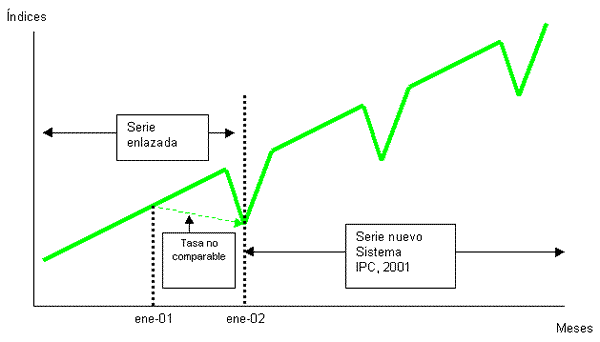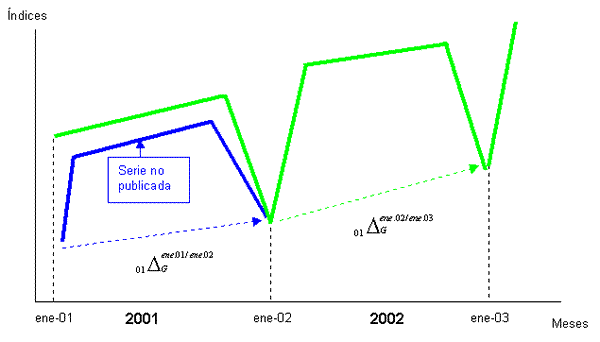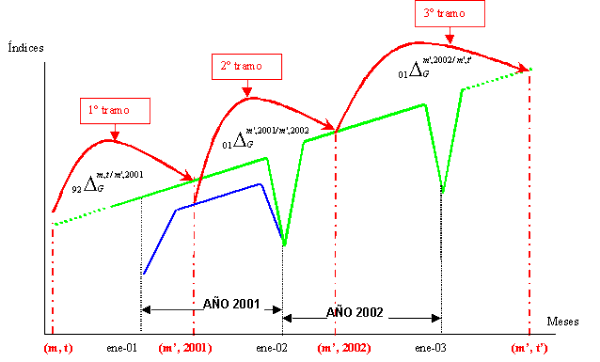
INEbase / Society / Standard, quality and conditions of life / New system CPI Base 2001
|
The effect of the inclusion of sales in the CPI
Introduction
The problem of the introduction of sale prices Calculation of annual variation rates during 2002 Calculation of variation rates between periods belonging to different bases Example of the effect of the inclusion of sales prices in the CPI Simulated Price Index series with sales The implementation of one new CPI base means a rupture in the continuity of the series of prices indices that are published. Until now, the method followed for any change of base has been the same: in order to obtain a homogeneous series the link is resorted to, specifically, the legal link. This consists of calculating a coefficient which establishes the relation between the old system and the new System, in December of the last year of the System which disappears, by means of the price indices for that month calculated under the old base using the old methodology and under the new base using the new methodology. The coefficient calculated will multiply the bases series of indices in such a manner that they transform into a new base series. This coefficient maintains the variation rates previously published and is known as legal because it is the one the INE applies in its official certificates. The problem of the introduction of sale prices The inclusion of sales prices supposes that the new CPI will cover prices that have suffers reductions for reasons such as sales and promotions, as well as those whose decreases are due to official sales periods. Evidently, the majority of divisions that make up the CPI will be affected, although reductions due to sales will be accentuated in divisions such as clothing, footwear, household appliances, etc, where these are more usual. In this way, the annual rate will not be affected by any methodological change as it is comparing each index published during 2002 with the index from the same month of 2001 in base 2001. That is, with sales prices and weightings and shopping basket from base 2001. 
As can be observed, in January 2002, date of the entry into force of the new system there is a significant reduction of the index due to the inclusion of sales prices; thus, the annual rate of this month (for which the linked index in January 2001 will be used) will be influenced by the methodological change which supposes the inclusion of sales prices. This would also occur in the remaining months of the year. So, this is a methodological problem whose solution must be subject to the last objective of the CPI: to measure the development over time of the level of prices of consumer goods and services. This means that it is interesting to obtain monthly, annual and accumulated variation rates that represent as faithfully as possible the real development of the prices. As has been seen, if the legal link is used, some monthly and accumulated rates are obtained real from 2002 but the same does nor occur with the annual rates. The solution to be adopted is detailed below. The calculation of annual rates during 2002 will be carried out with the indices from 2002 and the non-published indices (which include sales prices) from 2001. Therefore, in the calculation of annual rates base 1992 indices linked as in previous base changes will not be considered. The following schema represents the solution to be adopted. 
In order to establish 2001 as the base period for the new System, it is necessary to calculate the monthly price indices according to the new methodology (it is indicated as non published series in the chart). These indices will additionally serve for calculating the annual rates for each month of 2002, since they are calculated with the sales prices and are therefore perfectly comparable with the ones that will be published as of January 2002. In this way, the annual rate will not be affected by any methodological change as it is comparing each index published during 2002 with the index from the same month of 2001 in base 2001. That is, with sales prices and weightings and shopping basket from base 2001. However, given that the indices in base 2001 for the months of 2001 are not public, if you wish to calculate the annual variation rates as up to now, with published indices, variations different to those that the INE will supply will be obtained. This is something new as up to now, the published rates could be obtained from the published indices. Calculation of variation rates between periods belonging to different bases The method described serves to solve the problem of calculating the annual variation rates from January 2002; however, there still persists the problem of the lack of continuity of CPI series which prevents calculating variation rates between the two periods of different bases where the final period is subsequent to 2001 and including more than one year between them. This is not just a rupture that affects the scope of the analysts and studies of inflation but it also affects all legal contracts that use the CPI and need to know the variation of the CPI between two moments in time belonging to different bases. As long as the initial period corresponds to 2001 and the final period is equal or later than 2002 indices will be used in base 2001 which will not be published for the first of the periods. Nevertheless, the variation rates will be calculated previously by the INE and made available to the public. When the initial period is previous to 2001 the only indices available do not include sales prices. Therefore it is necessary to use the variation calculation method that solves the problem mentioned previously. This method is based on two fundamental premises:
In this way, the variation rates of prices between two periods when the first is previous to January 2001 and the second is equal or subsequent to 2002 will be calculated by partsIN other words, if you wish to know what the CPI variation was from month m of year t' (t' >= 2002) the following temporary sections will be considered: - Variation m t / m' 2001 As may be observed:
The price variations for the first and third section can be calculated with the published indices, while the second sections variation will be the one published, obtained upon comparing the indices based in 2001 for both periods. How to calculate these variation rates is presented in the following schema:  In order to facilitate obtaining the variation rates described for the users, these will be previously calculated by the INE and made available to the public by means of the Internet or distributed via customer service windows. |


